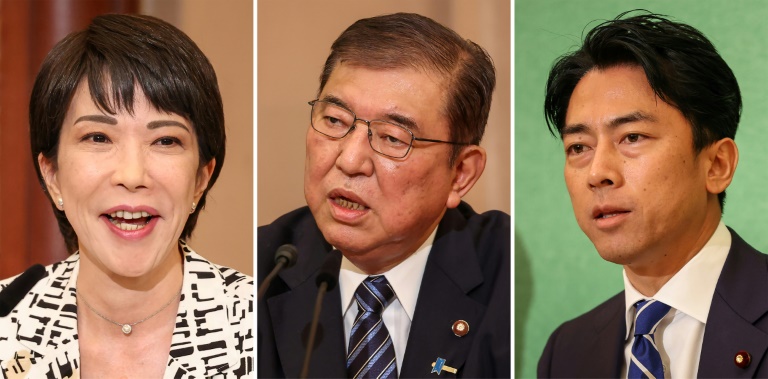Japan ruling party votes for next PM

Frontrunners include Sanae Takaichi (L), who could be Japan’s first woman premier, ex-defence minister Shigeru Ishiba and Shinjiro Koizumi, who would be the country’s youngest PM – Copyright AFP Ludovic MARIN
Hiroshi Hiyama and Katie Forster
Japan’s ruling party will choose the nation’s leader in a vote on Friday, with three frontrunners: the surfing son of a former prime minister, a veteran defence geek and an arch-nationalist who would be the country’s first woman premier.
A record nine candidates are in the running after the long-powerful factions of the Liberal Democratic Party (LDP) disbanded earlier this year over a funding scandal.
Because the conservative LDP holds a parliamentary majority, the winner is certain to become prime minister, and will likely call a snap election to shore up their mandate.
Polls indicate a toss-up between former defence minister Shigeru Ishiba, 43-year-old Shinjiro Koizumi, whose father was prime minister in the 2000s, and hawkish Sanae Takaichi, a rare prominent woman in Japanese politics.
“This is the most unpredictable that an LDP election has been in many years,” Jeffrey J. Hall, a lecturer at Kanda University of International Studies, told AFP.
Whoever wins must face down regional security threats, from an increasingly assertive China and its deepening defence ties with Russia to North Korea’s banned missile tests.
At home, the leader will be tasked with breathing life into the economy, as the central bank moves away from decades of monetary easing that has slashed the value of the yen.
LDP presidents are in office for three years and can serve up to three straight terms. Unpopular Prime Minister Fumio Kishida is not running for re-election.
With the factions dissolved, it’s unlikely any one candidate will win enough votes — split between lawmakers and rank-and-file party members — to win outright.
That makes a run-off between two top candidates the most likely scenario, with the winner announced on Friday afternoon.
– ‘Fair and square’ Ishiba –
Ishiba, 67, has come close to the top job before, including in 2012 when he lost to Shinzo Abe, Japan’s longest-serving leader who was later assassinated.
The military model-maker with an affinity for 1970s pop idols argues he is uniquely qualified for the job because he has experienced many setbacks when tackling tough social issues, such as agriculture reforms.
“Japan’s population will sharply decline from now on. Unless we take drastic action, the economy will not grow,” he said in a debate this week.
Yu Uchiyama, a political science professor at the University of Tokyo, said that “with public discontent with the LDP rising, the tide is in favour of Ishiba and his ‘fair and square’ attitude”.
Economic Security Minister Takaichi, 63, is opposed to changing the law to allow separate surnames for married couples, and regularly visits Tokyo’s Yasukuni war shrine — a flashpoint in relations with South Korea and China.
“Japan is completely looked down on by China,” she told Fuji Television when asked about the first confirmed incursion by a Chinese military aircraft into Japan’s airspace, which happened in August.
Naofumi Fujimura, a professor at the Graduate School of Law at Kobe University, said that while, for now, Takaichi needs the support of the LDP’s right-wingers, she could perhaps be “more centrist, or more pragmatic” as prime minister.
– Koizumi offers ‘rejuvenation’ –
Former environment minister Koizumi would be Japan’s youngest-ever prime minister, but critics say he is too inexperienced to lead the country.
A keen surfer, Koizumi “best personifies the idea of rejuvenation and change for the LDP” among the frontrunners, but LDP voters could think he “lacks stability”, Uchiyama said.
“For future generations, I will carry out labour market reforms and provide assistance for start-ups,” Koizumi said this week.
Other candidates include reformist Taro Kono, 61, chief cabinet secretary Yoshimasa Hayashi and Takayuki Kobayashi — the only other candidate under 50, who is seen as a wild card by some pundits.
Whoever emerges victorious on Friday will be formally elected by parliament on October 1.
The LDP has governed Japan almost uninterrupted for decades, with the main opposition parties rarely seen as viable alternatives.
During his term, Kishida has taken steps to double Japan’s defence spending, opening the door for military exports as the LDP seeks to revise the pacifist post-war constitution.
He welcomed Ukrainian President Volodymyr Zelensky to a G7 summit in Hiroshima, and has strengthened Japan’s often testy ties with its neighbour South Korea.
But his rule was also tarnished by scandals, voter anger over rising prices and sliding poll ratings.
Japan ruling party votes for next PM
#Japan #ruling #party #votes





